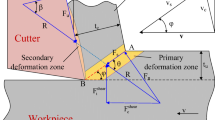Abstract
This paper presents an analytical method based on the unequal division shear-zone model to study the machining predictive theory. The proposed model only requires workpiece material properties and cutting conditions to predict the cutting forces during the orthogonal cutting process. In the shear zone, the material constitutive relationship is described by Johnson–Cook model, and the material characteristics such as strain rate sensitivity, strain hardening, and thermal softening are considered. The chip formation is supposed to occur mainly by shearing within the primary shear zone. The governing equations of chip flow through the primary shear zone are established by introducing a piecewise power law distribution assumption of the shear strain rate. The cutting forces are calculated for different machining conditions and flow stress data. Prediction results were compared with the orthogonal cutting test data from the available literature and found in reasonable agreement. In addition, an analysis of the deviation from experimental data for the proposed model is performed, the effects of cutting parameters and tool geometry were investigated.
Similar content being viewed by others
References
Ding TC, Zhang DS, Wang YW, Zhu XL (2010) Empirical models and optimal cutting parameters for cutting forces and surface roughness in hard milling of AISI H13 steel. Int J Adv Manuf Technol 3:18–28
Oxley PLB (1989) Mechanics of machining. Ellis Horwood, Chichester
Adetoro OB, Wen PH (2010) Prediction of mechanistic cutting force coefficients using ALE formulation. Int J Adv Manuf Technol 46:79–90
Third Wave AdvantEdgeTM (2006) Third Wave system Inc., Minneapolis, USA.
Merchant ME (1944) Basic mechanics of the metal cutting process. ASME J Appl Mech 66:168–175
Merchant ME (1945) Mechanics of the metal cutting process. J Appl Phys 16(5):267–275
Oxley PLB (1961) A strain-hardening solution for the shear angle in orthogonal metal cutting. Int J Mech Sci 3:68–79
Oxley PLB, Welsh MJM (1963) Calculating the shear angle in orthogonal metal cutting from fundamental Stress, strain, strain rate properties of the work material. In: Proceedings of the 4th International Machine Tool Design and Research Conference, Oxford. pp. 73–86.
Adibi-Sedeh AH, Madhavan V, Bahr B (2003) Extension of Oxley’s analysis of machining to use different material models. J Manuf Sci Eng 125:656–666
Lalwani DI, Mehta NK, Jain PK (2009) Extension of Oxley’s predictive machining theory for Johnson and Cook flow stress model. J Mater Process Technol 209:5305–5312
Astakhov VP, Osman MOM, Hayajneh MT (2001) Re-evaluation of the basic mechanics of orthogonal metal cutting: velocity diagram, virtual work equation, and upper bound theorem. Int J Mach Tools Manuf 41:393–418
Tounsi N, Vincenti J, Otho A, Elbestawi MA (2002) From the basics of orthogonal metal cutting toward the identification of the constitutive equation. Int J Mach Tools Manuf 42(2):1373–1383
Dudzinski D, Molinari A (1997) A modelling of cutting for viscoplastic materials. Int J Mech Sci 39(4):369–389
Ozlu E, Budak E, Molinari A (2007) Thermomechanical modeling of orthogonal cutting including the effect of stick-slide regions on the rake face. In: Proceedings of the 10th CIRP international workshop on modeling of machining operations, Calabria, Italy
Johnson W, Mellor PB (1983) Engineering plasticity. Wiley, New York
Moufki A, Devillez A, Dudzinski D, Molinari A (2004) Thermomechanical modelling of oblique cutting and experimental validation. Int J Mach Tools Manuf 44:971–989
Grzesik W (2008) Advanced machining processes of metallic materials. Elsvier, London
Leopold J (1999) Mechanical and physical models of machining. In: Proceedings of the 2th CIRP international workshop on modeling of machining operations, Nantes, France. pp. 24–25.
Fang N (2005) A new quantitative sensitivity analysis of the flow stress of 18 engineering materials in machining. J Eng Mater Technol 9:192–196
Shaw MC (1984) Metal cutting principles. Oxford University Press, Oxford
Komanduri R, Hou ZB (2000) Thermal modeling of the metal cutting process, part I: temperature rise distribution due to shear plane heat source. Int J Mech Sci 42:1715–1752
Childs THC (1998) Material property needs in modeling metal machining. In: Proceedings of the 1th CIRP international workshop on modeling of machining operations, Atlanta. pp. 193–202.
Keccecioglu D (1958) Shear strain rate in metal cutting and its effect on shear flow stress. Trans ASME 80:158
Jaspers SPFC, Dautzenberg JH, Taminiau DA (1998) Temperature measurement in orthogonal metal cutting. Int J Adv Manuf Technol 14:7–12
Umbrello D, Saoubi RM, Outeiro JC (2007) The influence of Johnson-Cook material constants on finite element simulation of machining of AISI 316L steel. Int J Mach Tools Manuf 47:462–470
Chandrasekaran H, Saoubi RM, Chazal H (2005) Modelling of material flow stress in chip formation process from orthogonal milling and split Hopkinson bar test. Mach Sci Technol 9:131–145
Author information
Authors and Affiliations
Corresponding author
Rights and permissions
About this article
Cite this article
Li, B., Wang, X., Hu, Y. et al. Analytical prediction of cutting forces in orthogonal cutting using unequal division shear-zone model. Int J Adv Manuf Technol 54, 431–443 (2011). https://doi.org/10.1007/s00170-010-2940-8
Received:
Accepted:
Published:
Issue Date:
DOI: https://doi.org/10.1007/s00170-010-2940-8




